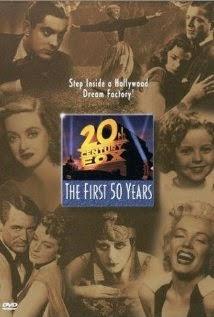
Directed By: Kevin Burns
Starring: James Coburn, Julie Andrews, Roddy McDowall
Tag line: "Step Inside a Hollywood Dream Factory"
Trivia: The fifty years covered are 1915 through 1965
Director Kevin Burns’ 1997 documentary 20th Century Fox: The First 50 Years is a veritable feast for cinephiles; an intensive documentary about one of the major Hollywood studios that, over the course of 2+ hours, shows us how it got so big in the first place.
Narrated by James Coburn, 20th Century Fox: The First 50 Years shuttles us back to the beginning, when Hungarian immigrant William Fox, toiling in New York’s garment district, decided to take a chance on the brand-spanking new motion picture industry. Selling everything he owned, Fox opened a chain of theaters, and before long was producing his own movies (his first being Life’s Shop Window in 1914). Hoping to expand, he eventually moved his fledgling company, Fox Films Corp., to the west coast, settling in the up-and-coming town of Hollywood, California. With the help of actress Theda Bara (who, in films like 1917’s Cleopatra and The She-Devil in 1918, gave birth to the Hollywood “Vamp”) and a series of popular westerns (including John Ford’s The Iron Horse), Fox was soon a major force in the industry, and even though he lost the race for introducing sound to movies (Warner Bros. beat him to the punch with 1927’s The Jazz Singer), Fox’s sound-on-film system would become the standard for decades to come (among the earliest pictures to feature this new technology was F.W. Murnau’s brilliant award-winning masterpiece, 1927’s Sunrise).
Soon after the stock market crash of 1929, a nearly bankrupt Fox was forced out of the studio he founded, clearing the way for Darryl Zanuck to take the helm. Merging Fox with his own company, 20th Century Pictures, Zanuck would lead this new powerhouse (aptly named 20th Century Fox) into Hollywood’s Golden age, introducing future stars like Spencer Tracy and Humphrey Bogart to movie audiences (both actors made their feature film debut in 1930’s Up the River) and producing some of John Ford’s most beloved classics (Drums Along the Mohawk, The Grapes of Wrath, How Green Was My Valley). During World War II, Zanuck, who volunteered with the Signal Corps, instructed his studio to concentrate on flag-waving war films (Winged Victory, Guadalcanal Diary) and lighthearted musicals (most starring Betty Grable, who’d become the most popular pin-up girl for G.I’s serving overseas), which gave Americans hope, and something to smile about, during this difficult time.
Oddly enough, the above only brings us to the halfway point of 20th Century Fox: The First 50 Years. And believe it or not, the second half is every bit as extensive, covering the turbulent 1950s, when TV forced movie screens to get bigger (with Fox leading the way with 1953’s The Robe, the first film presented in the Cinemascope widescreen process) and a young starlet named Marilyn Monroe (Gentlemen Prefer Blondes, The Seven Year Itch) took Hollywood by storm. From social consciousness (Gentleman’s Agreement, The Snake Pit) to Rodgers and Hammerstein musicals (Oklahoma, The King and I), and from Sci-Fi ( The Fly, The Day the Earth Stood Still) to Elvis Presley (Love Me Tender), 20th Century Fox remained on the cutting edge. Hell, they even found a way to survive the debacle that was the production of 1963’s Cleopatra, which ran years over schedule and millions of dollars over budget. The good times and the bad, the classics and the box office duds, are all there for the taking in this exhaustive, highly informative documentary.
There are brief interviews with some former stars (Roddy McDowall, Debbie Reynolds), but for the most part, 20th Century Fox: The First 50 Years is all about the movies, told by way of clips from over a hundred of the studio’s films. This, coupled with Coburn’s narration, makes 20th Century Fox: The First 50 Years much more than a history lesson; it’s an homage to Hollywood’s illustrious past, and a celebration of all the cinema has to offer.
